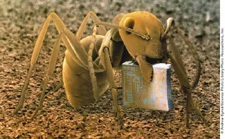 |
||
|
Unit
9 |
Scientific developments relevant to Unit 9
|
|
||||
| millerandlevine.com |
|
Unit 9
Chordates
At the beginning of Unit 9, Ken Miller and Joe Levine posed these questions about the scientific future:
• What environmental factors are causing declines in amphibian populations — and what do those declines mean for the health of ecosystems?
• Just how and when did the first four-limbed vertebrates leave the water for the land?Scientific developments relevant to Unit 9
What environmental factors are causing declines in amphibian populations ‹ and what do those declines mean for the health of ecosystems?
You may wonder why this question is important enough to be featured here. One reason is that other animals can act as "canaries in the coal mine" - alerting us to environmental changes that we wouldn't otherwise notice, but which may have effects on our health or other aspects of our lives. Another reason is that learning about interactions between environmental conditions and the health of other species can help us understand similar interactions that directly affect humans.
Student Discovery of Deformed Frogs has Great Impact
http://www.rice.edu/armadillo/Projects/Ecodillo/Earthfocus/Winter96/frog1.htm
It's pretty common for kids to go to nearby ponds or lakes and catch frogs. Lots of kids have done it. Typical, right? Not always. A group of students from the Minnesota New Country School in Le Sueur, Minnesota have found it to be a pretty unusual experience.
Emerging Infectious Diseases and Amphibian Population Declines
http://www.cdc.gov/ncidod/eid/vol5no6/daszak.htm#Figure%204
Most medical people think of the term łEmerging infectious diseases˛ only in reference to humans. But new or suddenly-spreading diseases have been reported increasingly as causes of death in free-living wild animals. Here's a report form an online journal of the U.S. Centers for Disease Control.
AmphibiaWeb is a site inspired by global amphibian declines. This online system allows free access to information on amphibian biology and conservation. http://www.amphibiaweb.org/
Just how and when did the first four-limbed vertebrates leave the water for the land?
New Fossil: Link Between Fish and Land Animals?
http://news.nationalgeographic.com/news/2002/07/0703_020703_TVtetrapod.html
What creature first crawled out of the prehistoric swamps to conquer the land? The question has long puzzled paleontologists because the transitional species seems to have lived during a mysterious 30-million-year gap in the fossil record called Romer's Gap. Check out this feature from National Geographic Today
Recent Findings (Fishes With Legs)
http://www.mdgekko.com/devonian/Order/new-order.html
Until very recently, the fossil record of early four-limbed vertebrates was basically limited to Ichthyostega, which lived during the Late Devonian in what is now eastern Greenland. But the fossil record from this period has expanded dramatically over the last 15 years. These new records findings are driving a new understanding of how four-limbed vertebrates evolved. Instead of envisioning fish escaping shrinking ponds, the first tetrapods are now seen as fishes with legs.
Devonian Period--Lobefins, Lungfish, Amphibians, and Tetrapod Evolution
http://tolweb.org/tree?group=Terrestrial_vertebrates&contgroup=Sarcopterygii
This page, on the regularly-updated Tree of Life project, offers a good summary of the current fossil record of the transition between fishes and amphibians. A table is provided that includes the names of the known "transitional" tetrapods (four-legged animals) with links to summaries and Web sites for those animals.
millerandlevine.com